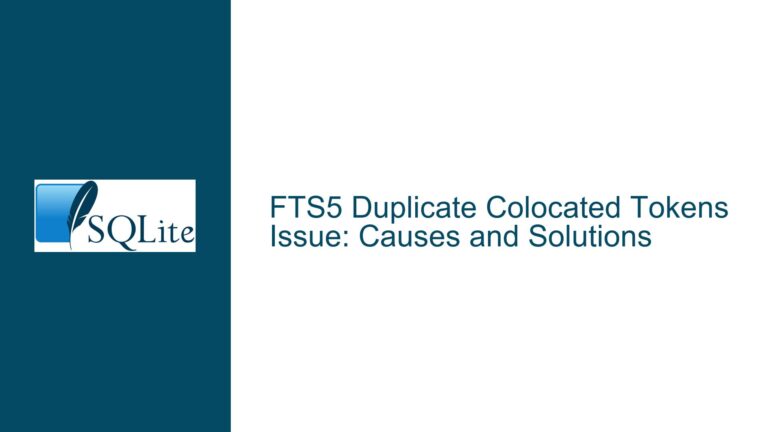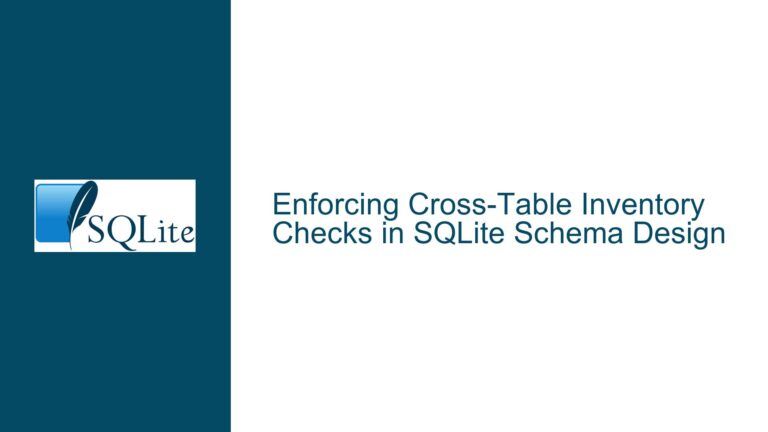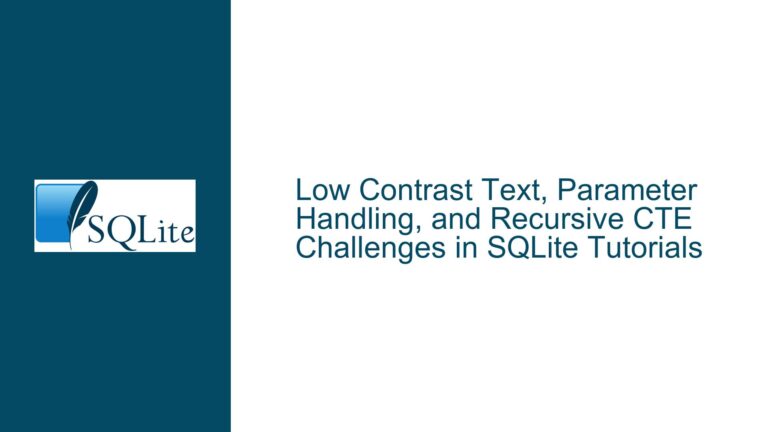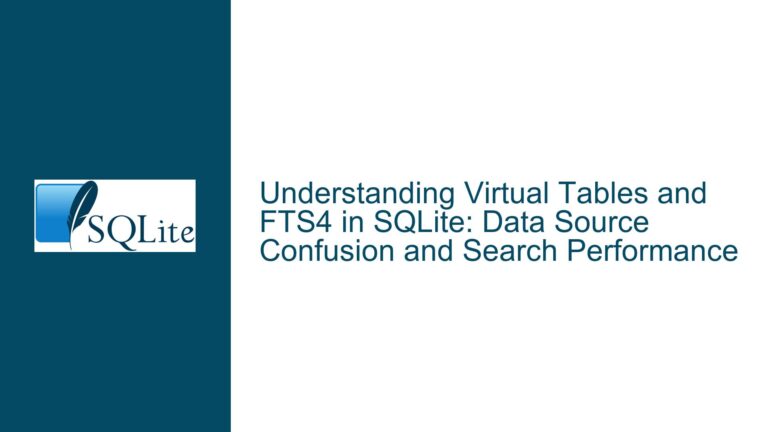Automated SQLite Schema Generation Pitfalls: Risks in PlantUML and AI Conversions
Challenges in Automated ER Diagram to SQLite Schema Conversion
The process of generating SQLite schemas from PlantUML ER diagrams via AI tools introduces efficiency gains but carries inherent risks of misalignment between the conceptual model and the final schema. While tools like GPT, Bard, or Bing can rapidly convert PlantUML’s text-based diagrams into SQLite-compatible DDL (Data Definition Language) statements, subtle discrepancies often emerge due to mismatches in syntax interpretation, ambiguous type mappings, and incomplete constraint enforcement. For instance, a PlantUML <<FK>> stereotype might not always resolve to a valid FOREIGN KEY clause if cardinality or referential actions are underspecified. Similarly, <<generated>> markers intended to denote AUTOINCREMENT fields may fail to propagate correctly if the AI misinterprets placement or context. These issues compound when schemas involve composite keys, junction tables, or non-standard column modifiers. The absence of explicit index definitions in PlantUML further exacerbates performance bottlenecks, as AI models rarely infer optimal indexing strategies.
The core challenge lies in reconciling PlantUML’s diagrammatic shorthand with SQLite’s strict parsing rules. While PlantUML allows rapid visualization of entities and relationships, its abstraction layer can obscure critical schema details. For example, a PlantUML VARCHAR(255) declaration might map to SQLite’s TEXT type without issue, but an INT could be misinterpreted as INTEGER (valid) or NUMERIC (suboptimal). Ambiguities in nullability constraints also arise: PlantUML’s lack of explicit NOT NULL markers outside primary keys forces AI models to guess column nullability based on incomplete hints. This creates schemas where required fields permit NULL values, violating business rules.
Root Causes of Schema Generation Errors in AI-Assisted Conversions
1. Misinterpretation of PlantUML Stereotypes and Annotations
PlantUML’s use of stereotypes (e.g., <<generated>>, <<FK>>) relies on consistent application to trigger correct SQLite features. AI models trained on heterogeneous SQL examples may conflate AUTOINCREMENT with AUTO_INCREMENT (MySQL syntax) or omit it entirely if the stereotype is misplaced. For instance, a primary key column labeled id <<generated>> should map to INTEGER PRIMARY KEY AUTOINCREMENT, but models might omit AUTOINCREMENT if the training data lacks SQLite-specific examples. Similarly, <<FK>> annotations attached to columns instead of relationships may fail to produce valid REFERENCES clauses.
2. Type Mapping Inconsistencies
SQLite’s type affinity system (e.g., TEXT, INTEGER, REAL, BLOB, NUMERIC) does not align perfectly with PlantUML’s generic types. AI models often default to simplistic mappings: STRING becomes TEXT, DOUBLE becomes REAL, but nuanced cases like DATETIME or BOOLEAN require explicit overrides (TEXT for ISO-8601 strings, INTEGER for 0/1 flags). Without explicit directives, AI-generated schemas may use incompatible types, necessitating manual corrections.
3. Constraint Under-Specification
PlantUML diagrams frequently omit UNIQUE, CHECK, or DEFAULT constraints to reduce clutter. AI models, lacking context, exclude these unless explicitly prompted, resulting in schemas that permit duplicate entries or invalid domain values. For example, an email column without a UNIQUE constraint might allow duplicate addresses despite business requirements.
4. Foreign Key Integrity Gaps
While PlantUML relationships (e.g., Customer }|--|| Order) imply foreign keys, AI models may omit ON DELETE or ON UPDATE actions unless explicitly annotated. This leads to cascading deletion issues or orphaned records. Additionally, models might fail to index foreign key columns, degrading query performance.
5. Schema Normalization Oversights
AI-generated schemas often lack normalization for junction tables (many-to-many relationships) or derived columns. For example, a PlantUML association between Student and Course might produce a StudentCourse table without a composite primary key, risking duplicate enrollments.
Validating and Correcting AI-Generated SQLite Schemas from PlantUML Sources
Step 1: Audit Type Mappings
Review each column’s data type in the generated schema against SQLite’s type affinity rules. For instance, ensure DATETIME columns use TEXT with ISO-8601 formatting or INTEGER for Unix timestamps. Correct mismatches like BOOLEAN mapped to TEXT instead of INTEGER.
Step 2: Enforce Constraints
Verify that all NOT NULL constraints are applied to non-primary-key columns requiring mandatory values. Add CHECK constraints for domain validation (e.g., CHECK (status IN ('active', 'inactive'))). Explicitly define UNIQUE constraints for columns like email or username.
Step 3: Refine Foreign Key Relationships
Ensure every <<FK>> stereotype translates to a FOREIGN KEY clause with explicit REFERENCES and referential actions. For example:
FOREIGN KEY (customer_id) REFERENCES Customer(id) ON DELETE CASCADE
Add indexes to foreign key columns to optimize join performance:
CREATE INDEX idx_order_customer_id ON Order(customer_id);
Step 4: Implement Primary Key and Auto-Increment Logic
Confirm that <<generated>> columns use INTEGER PRIMARY KEY AUTOINCREMENT for rowid-based tables. Avoid AUTOINCREMENT unless necessary, as SQLite automatically reuses rowids from deleted rows without it.
Step 5: Normalize Composite and Surrogate Keys
Inspect junction tables (e.g., StudentCourse) for composite primary keys spanning foreign keys:
CREATE TABLE StudentCourse (
student_id INTEGER NOT NULL,
course_id INTEGER NOT NULL,
PRIMARY KEY (student_id, course_id),
FOREIGN KEY (student_id) REFERENCES Student(id),
FOREIGN KEY (course_id) REFERENCES Course(id)
);
Replace surrogate keys unless required for external system compatibility.
Step 6: Test Schema Integrity
Populate tables with sample data to validate constraints. For example, attempt to insert NULL into a NOT NULL column or duplicate values into a UNIQUE column. Use SQLite’s PRAGMA foreign_key_check; to identify orphaned records.
Step 7: Optimize Indexing Strategy
Analyze query patterns with EXPLAIN QUERY PLAN and add indexes for frequently filtered or joined columns. Avoid over-indexing to reduce write overhead.
Step 8: Version Control Iterations
Maintain versioned SQL scripts for schema changes, enabling rollbacks if AI-generated code introduces regressions. Use migration tools like sqlite3_diff to track alterations.
By systematically addressing these areas, developers can harness the speed of AI-assisted schema generation while ensuring robustness and compliance with SQLite’s operational semantics.






